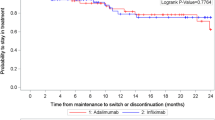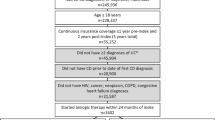Abstract
Introduction
Few published reports have described the impact of adherence with biologic agents on hospitalizations and inpatient costs in Crohn’s disease (CD).
Methods
A retrospective claims analysis using the IMS LifeLink Health Plan Claims Database between September 1, 2004 and June 30, 2009 was conducted. Continuous enrollment for 12 months before and 12 months after the index date was required. Patients were required to have ≥2 claims with an International Classification of Diseases, 9th Edition, Clinical Modification diagnosis code for CD (555.xx) preindex, be ≥18 years of age at index, and have ≥4 infliximab infusions with a gap no greater than 12 weeks between each infusion. Patients with 7–9 infliximab infusions (12 months postindex) were considered adherent; patients with 4–6 infliximab infusions were considered nonadherent.
Results
In total, 638 patients were included in the analyses (mean age, 43 years; 58% female in the adherent group and 53% in the nonadherent group). The number of patients who met the definition of adherence was 466 (73%). A smaller proportion of adherent patients had a CD-related emergency room visit, compared with nonadherent patients (11% vs. 17%, P=0.029). A smaller proportion of adherent patients required CD-related hospitalization, compared with nonadherent patients (8% vs. 12%, P=0.117). Among those hospitalized, adherent patients had fewer mean [median] days in the hospital (5.9 [5] days), compared with nonadherent patients (12.8 [8] days, P=0.015). Mean [median] hospital costs were significantly lower for adherent patients ($13,427 [$9,352]), compared with nonadherent patients ($37,783 [$28,864], P=0.001). Multivariate analyses confirmed lower inpatient (P<0.001) costs for adherent versus nonadherent patients.
Conclusion
Adherence with infliximab therapy during the first year of treatment in patients with CD was associated with a shorter hospital length of stay and lower inpatient costs compared with nonadherent patients. Strategies for increasing adherence rates to infliximab maintenance therapy may be valuable in reducing hospitalizations and inpatient costs in patients with CD.
Similar content being viewed by others
References
Loftus EV Jr., Schoenfeld P, Sandborn WJ. The epidemiology and natural history of Crohn’s disease in population-based patient cohorts from North America: a systematic review. Aliment Pharmacol Ther. 2002;16:51–60.
Kappelman MD, Rifas-Shiman SL, Porter C, et al. Direct health care costs of Crohn’s disease and ulcerative colitis in United States children and adults. Gastroenterology. 2008;135:1907–1913.
Yu AP, Cabanilla LA, Wu EQ, Mulani PM, Chao J. The costs of Crohn’s disease in the United States and other Western countries: a systematic review. Curr Med Res Opin. 2008;24:319–328.
Cohen RD, Larson LR, Roth JM, Becker RV, Mummert LL. The cost of hospitalization in Crohn’s disease. Am J Gastroenterol. 2000;95:524–530.
Blomqvist P, Ekbom A. Inflammatory bowel disease: health care and costs in Sweden in 1994. Scand J Gastroenterol. 1997;32:1134–1139.
Bernstein CN, Papineau N, Zajaczkowski J, Rawsthorne P, Okrusko G, Blanchard JF. Direct hospital costs for patients with inflammatory bowel disease in a Canadian tertiary care university hospital. Am J Gastreoenterol. 2000;95:677–683.
Nguyen GC, Tuskey A, Dassopoulos T, Harris ML, Brant SR. Rising hospitalization rates for inflammatory bowel disease in the United States between 1998 and 2004. Inflamm Bowel Dis. 2007;13:1529–1535.
Bassi A, Dodd S, Williamson P, Bodger K. Cost-ofillness of inflammatory bowel disease in the United Kingdom: a single centre retrospective study. Gut. 2004;53:1471–1478.
Prescribing Information. REMICADE (infliximab). Malvern, PA: Centocor Ortho Biotech, Inc.; November 2009.
Targan SR, Hanauer SB, van Deventer SJH, et al. A short-term study of chimeric monoclonal antibody cA2 to tumor necrosis factor alpha for Crohn’s disease. N Engl J Med. 1997;337:1029–1035.
Hanauer SB, Feagan BG, Lichtenstein GR, et al. Maintenance infliximab for Crohn’s disease: The ACCENT I randomized trial. Lancet. 2002:359:1541–1549.
Sands BE, Anderson FH, Bernstein CN, et al. Infliximab maintenance therapy for fistulizing Crohn’s disease. N Engl J Med. 2004;350:876–885.
Present DH, Rutgeerts P, Targan S, et al. Infliximab for the treatment of fistulas in patients with Crohn’s disease. N Engl J Med. 1999;340:1398–1405.
Rutgeerts P, Van Assche G, Vermeire S. Optimizing anti-TNF treatment in inflammatory bowel disease. Gastroenterology. 2004;126:1593–1610.
Colombel JF, Rutgeerts P, Yan S, et al. Infliximab (Remicade) maintenance treatment results in lower hospitalization rate in Crohn’s disease patients. Gastroenterology. 2002;122(Suppl. 4):W1344.
Williams JB, Cross RK, Thameen D, et al. Longterm infliximab maintenance infusion regimens and rates of hospitalization, surgery and disability in Crohn’s disease patients. Gastroenterology. 2005;128(Suppl. 2):AW1076.
Williams JB, Weber LR, Beaulieu DB, et al. Longterm infliximab maintenance infusion regimens and rates of hospitalization, surgery, and disability in Crohn’s disease. Gastroenterology. 2006;130(Suppl. 2):A–143.
Schnitzler F, Fidder H, Ferrante M, et al. Longterm outcome of treatment with infliximab in 614 patients with Crohn’s disease: results from a singlecentre cohort. Gut. 2009;58:492–500.
Stein DJ, Ananthakrishnan AN, Issa M, et al. Impact of prior irregular infliximab dosing on performance of long-term infliximab maintenance therapy in Crohn’s disease. Inflamm Bowel Dis. 2010;16:1173–1179.
Lichtenstein GR, Yan S, Bala M, Blank M, Sands BE. Infliximab maintenance treatment reduces hospitalizations, surgeries, and procedures in fistulizing Crohn’s disease. Gastroenterology. 2005;128:862–869.
Rubenstein JH, Chong RY, Cohen RD. Infliximab decreases resource use among patients with Crohn’s disease. J Clin Gastroenterol. 2002;35:151–156.
Bokemeyer B, Teml A, Roggel C, et al. Adherence to thiopurine treatment in out-patients with Crohn’s disease. Aliment Pharmacol Ther. 2007;26:217–225.
Mantzaris GJ, Roussos A, Kalantzis C, Koilakou S, Raptis N, Kalantzis N. How adherent to treatment with azathioprine are patients with Crohn’s disease in longterm remission? Inflamm Bowel Dis. 2007;13:446–450.
Shaya FT, El Khoury AC, Wong W, et al. Persistence with pharmacotherapy for gastrointestinal disease: associated costs of health care. P T. 2006;31:657–665.
Higgins PD, Rubin DT, Kaulback K, Schoenfield PS, Kane SV. Systematic review: impact of nonadherence to 5-aminosalicylic acid products on the frequency and cost of ulcerative colitis flares. Aliment Pharmacol Ther. 2009;29:247–257.
Kane S, Shaya F. Medication non-adherence is associated with increased medical health care costs. Dig Dis Sci. 2008;53:1020–1024.
Kane S, Dixon L. Adherence rates with infliximab therapy in Crohn’s disease. Aliment Pharmacol Ther. 2006;24:1099–1103.
Kane SV, Chao J, Mulani PM. Adherence to infliximab maintenance therapy and health care utilization and costs by Crohn’s disease patients. Adv Ther. 2009;26:1–11.
PharMetrics, Inc. LifeLink Health Plan Claims Database. Watertown, MA: IMS Health; 2010.
Feagan BG, Vreeland MG, Larson LR, Bala MV. Annual cost of care for Crohn’s disease: a payor perspective. Am J Gastroenterol. 2000;95:1955–1960.
Cramer JA, Roy A, Burrell A, et al. Medication compliance and persistence: terminology and definitions. Value Health. 2008;11:44–47.
Jackson CA, Clatworthy J, Robinson A, Horne R. Factors associated with non-adherence to oral medication for inflammatory bowel disease: a systematic review. Am J Gastroenterol. 2010;105:525–539.
Author information
Authors and Affiliations
Corresponding author
Rights and permissions
About this article
Cite this article
Carter, C.T., Waters, H.C. & Smith, D.B. Impact of infliximab adherence on Crohn’s disease-related healthcare utilization and inpatient costs. Adv Therapy 28, 671–683 (2011). https://doi.org/10.1007/s12325-011-0048-7
Received:
Published:
Issue Date:
DOI: https://doi.org/10.1007/s12325-011-0048-7




